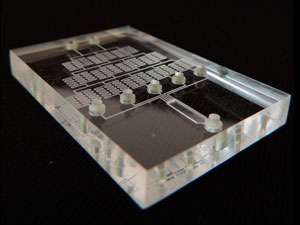On-the-spot diagnoses for diseases with a modular valve for microfluidic chips

Swapping delicate microscopic flow valves for a universal modular valve system has enabled A*STAR researchers to dramatically decrease the cost and complexity of microfluidic diagnostic chips—business card-sized devices that can analyse blood on the spot for a range of disease biomarkers.
"Microfluidic chips are advancing point-of-care diagnosis for many diseases," says Alicia Toh from A*STAR's Singapore Institute of Manufacturing Technology (SIMTech). "Inside these chips, tiny microvalves precisely direct microlitres of fluid through a series of microchannels for automated analysis. However, integrating microvalves into the microchannels is complex and highly susceptible to fabrication defects, which translates into a higher cost per device. In the medical diagnostic sector the race is on to lower the cost per diagnosis by producing cheaper microfluidic diagnostic chips."
Toh and her colleagues Zhiping Wang and Zhenfeng Wang addressed the problem by moving the microvalves off the main microfluidic chip, and created a modular valve that is fitted to the surface of the chip after fabrication. The valves consist of a microfluidic channel that connects to surface ports on the chip, and an air chamber that allows the channel to be pinched by increasing the air pressure. The team demonstrated that their modular valves could precisely manipulate chemical concentrations through fluidic routing, which is critical in many advance diagnostic applications.
"By mass producing these microvalve modules separate from the microfluidic chip and testing valve function prior to chip integration, we can achieve much lower defect rates, which boosts yields and results in a much lower cost per device," says Toh. "This technology will reduce waste and help contribute to sustainable manufacturing practices for microfluidic chips."
Getting the valve design right, however, was complicated. The team used state-of-the-art software to predict the microscopic interactions between the flexible elastomeric silicone membrane and the fluid in the microchannel. Using materials that are compatible with the latest microfluidics technologies was also a big constraint.
"The industry is rapidly moving toward more cost effective thermoplastic materials," says Toh. "By using compatible materials, we can achieve reliable integration without additional surface modification or adhesives."
Toh and her team are now exploring the production of microvalve modules using a variety of novel materials. "Greater adoption of microfluidic technology will mean that we could see our modular microvalves being used in a wide spectrum of applications," she says.
More information: Alicia G. G. Toh et al. Modular membrane valves for universal integration within thermoplastic devices, Microfluidics and Nanofluidics (2016). DOI: 10.1007/s10404-016-1753-y




















